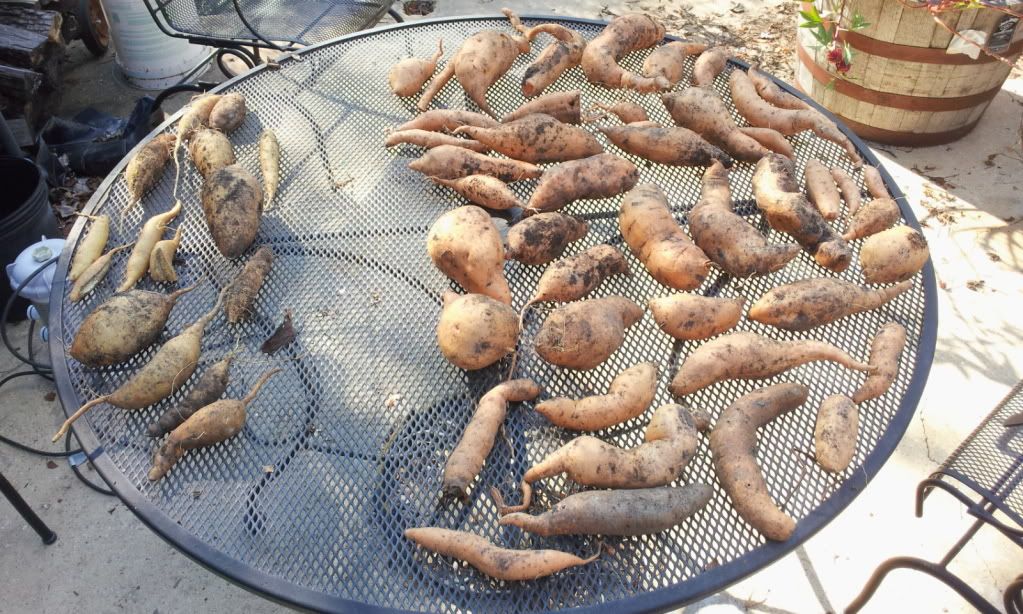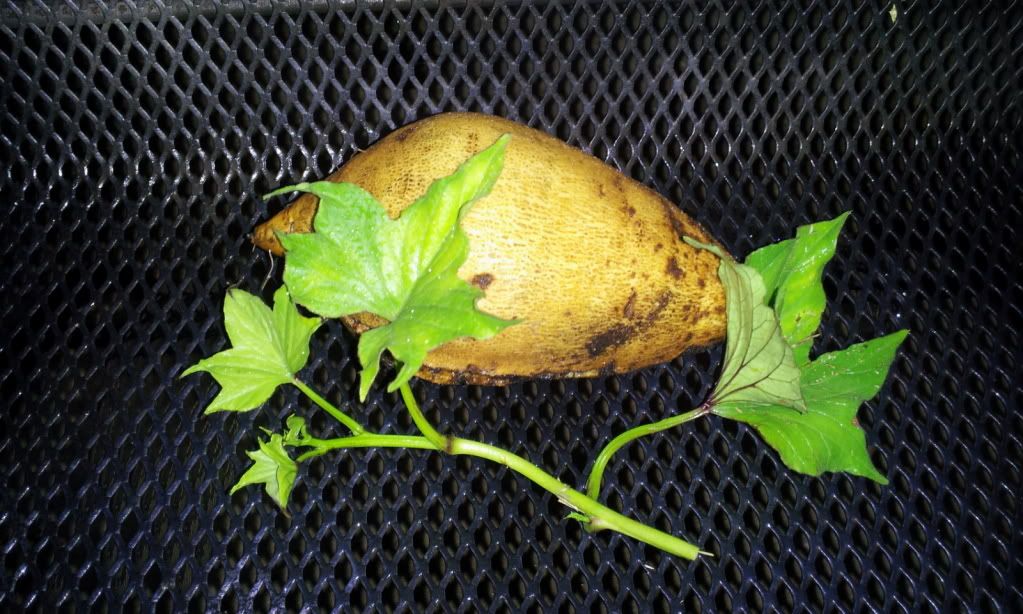|
|
Post by Drahkk on Sept 27, 2012 18:06:48 GMT -5
I dug my sweets today. This year's harvest is profoundly disappointing.  Those are Vardaman on the right, and the pitiful handful on the left is my entire harvest of Poplar Root. That table is usually heaped at least two layers deep. I also expected some oversized ones like I got last year, since I planted early and dug late. Instead, the few decent baking-sized roots I got are the largest ones. I believe I have three separate problems going on, two of which I could have prevented by following accepted planting methods instead of taking the lazy way out. First, instead of growing slips from a decent sized root, for the past few years (at least 3), I've been eating the big ones and saving a few handfuls of small ones for use as seed potatoes. I believe in so doing I've been inadvertently selecting for small size. Second, I had a significant number of partially rotten ones, so I did some research and recognized signs of both early and late infestations of root knot nematodes. I know I've seen the blisters before, too, so by replanting last year's roots I just infected the new bed. Dang it. Third, I believe I may also have reniform nematodes. I hadn't heard of them before today, but the description seems to fit. They cause the root system to be poorly developed, with fewer feeder roots. As a result, the potatoes don't size up properly. They also contribute to cracking, which I've seen, though much less this year than last. They're apparently becoming a major pest in LA, which is only a few miles from me as the crow flies. They also love to attack cotton, which is grown on many of the farms around me. Right now my plan is to start slips next spring from the largest roots that keep until then, and plant them in the northeast corner of my garden, which has never had sweet potatoes in it. That should end the nematodes, and hopefully start working toward larger roots again. I may also try to find some slips of a resistant variety or two, such as Bienville. Thoughts, anyone? MB |
|
|
|
Post by raymondo on Sept 29, 2012 18:33:10 GMT -5
Sounds like you've worked out the issues. I haven't grown sweet potatoes for years, not since I lived down on the coast. I love eating them though, one of my all time favourite vegies.
|
|
|
|
Post by littleminnie on Sept 29, 2012 21:30:19 GMT -5
I would buy slips in spring and that way you won't waste any of yours for eating and you will get healthy starts. I also dug lately (a week ago Friday). The harvest was not disappointing being I had to replant them and some passed away (gophers I think since they seem to have huge tunnels right under that spot. I wish they were easier to dig, especially when they get really big. The biggest broke into 3 chunks and I didn't even get the tail out. They rise up like a pod of whales don't you think?  |
|
Deleted
Deleted Member
Posts: 0
|
Post by Deleted on Sept 29, 2012 22:55:47 GMT -5
What are early and late, for you?
|
|
|
|
Post by Drahkk on Sept 30, 2012 0:40:06 GMT -5
I would buy slips in spring and that way you won't waste any of yours for eating and you will get healthy starts. I also dug lately (a week ago Friday). The harvest was not disappointing being I had to replant them and some passed away (gophers I think since they seem to have huge tunnels right under that spot. I wish they were easier to dig, especially when they get really big. The biggest broke into 3 chunks and I didn't even get the tail out. They rise up like a pod of whales don't you think?  To order new slips I'd have to remember where I got the original stock from...  The only thing available locally is Beauregard, which is the same one that is most popular among farmers in Louisiana, and I believe makes up most of the supermarket selection. I'm sure I can find them though; neither is that rare. A pod of whales is a pretty accurate analogy! Usually by this time of year the soil is very visibly humped up. One of the reasons I like Vardaman and Poplar Root is that they seem to form most of the harvest in the top 10 inches of soil. With raised beds, that means I can easily dig the majority of them by hand. I gave up on Nancy Halls, Porto Rico, and whatever variety that supermarket root I started with was because they tended to form so deep I broke a lot of them while digging. Nancy Halls also had the annoying habit of forming little one ounce potatoes anywhere it touched soil and could put down roots, which both took nutrients (and size) away from the main harvest and resulted in dozens of unwanted volunteers later on. But anyway, I'm rambling... What are early and late, for you? I usually plant in mid May and dig in mid September. This year we had a very mild winter and a warm spring, and I got overconfident and planted my sweets at the end of March. They didn't really get much of an early start, though. It was warm, but not warm enough; they came up very slowly, and didn't really pick up speed until May/June. As for the late dig, it was only by a couple of weeks. I usually dig around the middle of September. Until this year that's been plenty of time to get most of them to baking size, with daytime temps still in the 80s so I can cure them outside. MB |
|
|
|
Post by littleminnie on Sept 30, 2012 8:51:51 GMT -5
Hmm I wonder if the cool soil bothered them. I am not a sweet potato expert but generally plant June first and dig right before frost in mid to late September .
|
|
|
|
Post by castanea on Sept 30, 2012 10:54:25 GMT -5
I planted mine the second week, of July, the latest ever, and have no idea when to dig them up. I'm thinking maybe the end of October. I planted about 8 different vareities and I can tell that some are at different stages of growth. We're supposed to reach 100 today and tomorrow and the high 90s the next few days so they should be loving it right now.
|
|
|
|
Post by Drahkk on Sept 30, 2012 11:47:46 GMT -5
Hmm I wonder if the cool soil bothered them. I am not a sweet potato expert but generally plant June first and dig right before frost in mid to late September . I'm sure it did. I knew better; I just had planting fever and got overzealous. May is generally safe here, as I'm already getting high 90s by then, but March was way too early. Castanea, if you put them in that late, I'd leave them in as long as I could. I'm only digging in September to take advantage of my long warm season and cure them outside. That's what the farmers do: turn them to the surface and let them sun cure for a couple of days before collecting. But many folks say to leave them in until first frost kills the vines, and if they went in in July, that's exactly what I'd do. Different varieties take anywhere from 90 to 180 days to reach decent size (assuming none of the problems I had), with the average being about 120. Starting that late, you may end up having to save the largest of the pygmies for next year's slips. MB |
|
|
|
Post by castanea on Sept 30, 2012 12:14:15 GMT -5
Hmm I wonder if the cool soil bothered them. I am not a sweet potato expert but generally plant June first and dig right before frost in mid to late September . I'm sure it did. I knew better; I just had planting fever and got overzealous. May is generally safe here, as I'm already getting high 90s by then, but March was way too early. Castanea, if you put them in that late, I'd leave them in as long as I could. I'm only digging in September to take advantage of my long warm season and cure them outside. That's what the farmers do: turn them to the surface and let them sun cure for a couple of days before collecting. But many folks say to leave them in until first frost kills the vines, and if they went in in July, that's exactly what I'd do. Different varieties take anywhere from 90 to 180 days to reach decent size (assuming none of the problems I had), with the average being about 120. Starting that late, you may end up having to save the largest of the pygmies for next year's slips. MB Thanks for the advice. Our average first frost is mid December. Last year though it was mid November, which was truly odd, and some years we don't get one. I guess late October is the first date I will consider pulling them up and I will probably do it before Thanksgving unless we have another weird November frost. |
|
|
|
Post by DarJones on Sept 30, 2012 15:01:44 GMT -5
Sweet potatoes should never be planted until you have settled warm temps. That means May 1st for you and me. If you plant them earlier, the plants are phenotypically stunted and never produce the crop they should.
Whether you use the biggest or the smallest tubers to produce slips is irrelevant. What is important is whether they are infected with viruses. Generally, smaller roots are produced by plants that are infected so there is a bias that bigger roots generally produce healthier slips. A better way to select is to dig a hill of potatoes and select the most productive and healthiest hill to supply roots for next years slips. Look for the most uniform nice size roots in a hill with a lot of them.
Poplar root is a longer season variety than vardaman. You should leave Poplar in the ground 2 or 3 weeks longer. The only other long season variety I grow is Okinawan which takes 140 days to maturity. Poplar root is about 130 days. Vardaman is about 125 days. Georgia Jet is about 90 days.
My best suggestion is to get a few slips of Mahon for next year. It is the best producing sweet potato I've ever grown and has excellent culinary traits as well. In other words, it tastes ""Good"".
I almost forgot, if you want an easy way to harvest, get a trenching spade. This is a spade that is only 7 inches wide at the top but about 18 inches long. You can insert it under the sweet potatoes and just lift them out.
|
|
|
|
Post by 12540dumont on Oct 1, 2012 0:24:35 GMT -5
Dar, Thanks, good advice. How many days is Mahon?
I hate the digging of Sweet Potatoes. It's blasted hot here in September/October. As Castanea says, when it's a hundred out, I don't want to be digging. There's so much else to do, seeds to save, melons to harvest, broccoli to plant, garlic to plant....
|
|
|
|
Post by ferdzy on Oct 1, 2012 7:24:23 GMT -5
I don't know how useful this will actually be, but I found this book on line this summer and it made interesting reading... it's a guide to growing sweet potatoes from 1886. archive.org/details/sweetpotatocultu00fitz |
|
|
|
Post by Walk on Oct 1, 2012 8:58:10 GMT -5
I've found that you can sprout your sweet potatoes and eat them too. We Set aside mid-sized roots from nice hills for our "seed stock". In early spring, we start our slips with the seed potatoes laying on their side in a pan of perlite. The pan is watered and placed in a warm spot that has some indirect light. After the slips have sprouted and been removed, the seed stock is still in good condition to eat.
|
|
|
|
Post by Drahkk on Oct 1, 2012 19:05:30 GMT -5
Sweet potatoes should never be planted until you have settled warm temps. That means May 1st for you and me. If you plant them earlier, the plants are phenotypically stunted and never produce the crop they should. Whether you use the biggest or the smallest tubers to produce slips is irrelevant. What is important is whether they are infected with viruses. Generally, smaller roots are produced by plants that are infected so there is a bias that bigger roots generally produce healthier slips. A better way to select is to dig a hill of potatoes and select the most productive and healthiest hill to supply roots for next years slips. Look for the most uniform nice size roots in a hill with a lot of them. Poplar root is a longer season variety than vardaman. You should leave Poplar in the ground 2 or 3 weeks longer. The only other long season variety I grow is Okinawan which takes 140 days to maturity. Poplar root is about 130 days. Vardaman is about 125 days. Georgia Jet is about 90 days. My best suggestion is to get a few slips of Mahon for next year. It is the best producing sweet potato I've ever grown and has excellent culinary traits as well. In other words, it tastes "Good". I almost forgot, if you want an easy way to harvest, get a trenching spade. This is a spade that is only 7 inches wide at the top but about 18 inches long. You can insert it under the sweet potatoes and just lift them out. Thanks, Dar! Lots of good info! My sweets got rained on before I brought them in (oops!), and now that they're washed clean they look a lot healthier than I originally thought. The nematode issues may have just been in my head, I guess, especially if I stunted them by planting too early. I'll still be starting the right way from slips next year, though! Glad to know size doesn't matter, as long as the mother root is healthy. That means I haven't done any real harm by planting small ones, and I can share some of the small ones when I'm sure I have a healthy crop. I see SandHill has Mahon; I'll try a few next year. The leaves should make them easy to identify even if they get tangled up with the others. I may try some Okinawan, too. I'd looked at them before, but I thought they took 180 days; if they're only 140 for you I might have time to get a successful crop. Speaking of unique leaves, I saw Poplar Root listed on SandHill as having normal leaves. What I've been calling Poplar Root has five pointed, ivy-like leaves, so I'm no longer entirely sure what variety they are. The skin is rough and brown like a russet potato, with white flesh. They're usually very uniformly shaped, blocky, averaging 10-12 oz, very dry and very sweet.  Any chance this really is Poplar Root, or ideas what it might be? MB |
|
|
|
Post by paquebot on Oct 1, 2012 22:11:49 GMT -5
I grew 4 varieties this year and very pleased with 3 of them. Beauregard has always been the one which does best here and it didn't disappoint. Only thing I don't like about it is an annoying growth habit. There may be 10 plants in a row with all normal tubers and then the 11th may have a single monster. Had one that was 5¼ pounds and another was 4½. Centennial had been grown before with fair results and still only fair. To top off the low production and expansion cracks, also had scurf despite new ground and purchased slips. It won't be back next year. Georgia Jet had been grown several times before and was close to Beauregard for production this year. That's the one that I often got single monsters in the past but not this year. Big surprise was a chance to grow Covington. Had 60 plants which were very uniform and highly productive. From first to last plant dug, 10 plants would fill a bushel basket. That one will get the lion's share of garden space again next year.
Martin
|
|





 The only thing available locally is Beauregard, which is the same one that is most popular among farmers in Louisiana, and I believe makes up most of the supermarket selection. I'm sure I can find them though; neither is that rare.
The only thing available locally is Beauregard, which is the same one that is most popular among farmers in Louisiana, and I believe makes up most of the supermarket selection. I'm sure I can find them though; neither is that rare. 


 Any chance this really is Poplar Root, or ideas what it might be?
Any chance this really is Poplar Root, or ideas what it might be?